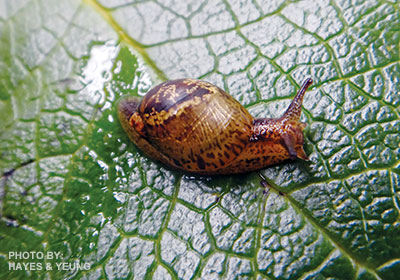
One of Yeung and Hayes’s colleagues, Marty Meyer, investigated the role that Hawaiian snails play in the ecosystem. He found that the minuscule mollusks serve a big function in the forest. They’re a food source for other native species — carnivorous caterpillars, and birds such as Hawaiian honeycreepers. More importantly, the snails help decompose and cycle nutrients back into the soil — an essential service in nutrient-poor Hawaiian forests. Unlike other snails that feed on plant tissue, pupu kuahiwigraze on the algae, bacteria, and fungi growing on the surface of leaves.
To scrape plants clean of parasitic growths, these mobile barbers use special mouth organs called radulae — something like conveyor belts punctuated by tiny teeth. Each snail species can be identified by its uniquely shaped radula, visible under electron microscope.
Now that fewer native snails inhabit the forest, hikers notice changes, says Yeung. “Old-timers say there’s a lot more fungus on trees now, so the trees are weaker.”
Of the ten native snail families,Achatinellidae is the best known. The famous O‘ahu tree snails,kahuli, belong to this family. Slow to mature, these forest jewels can reach twenty-five years of age and give live birth to one or two baby snails per year. Ancient Hawaiians prized kahuli for their beautiful shells, used in lei and referenced in folklore. An old Hawaiian chant, “Kahuli Aku,” tells of snails that chirp in the evening, asking golden plovers to fetch them water. Oral histories say these singing snails were once so abundant in the forest that they hung from trees like clusters of grapes.
Sadly, that’s no longer the case. Across Hawai‘i, pupu kuahiwi disappeared, due to loss of habitat, overharvesting by collectors, and predation by rats, Jackson’s chameleons, and rosy wolf snails.




